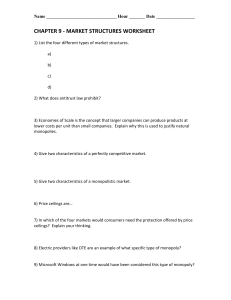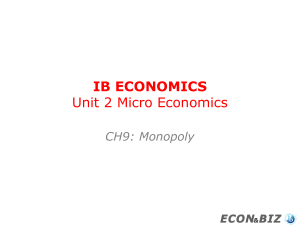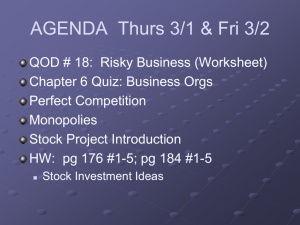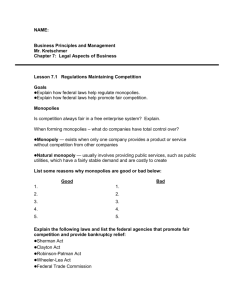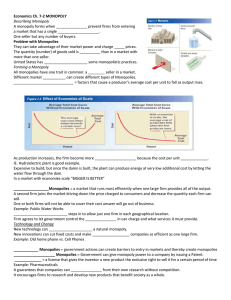Perfect Competition
advertisement
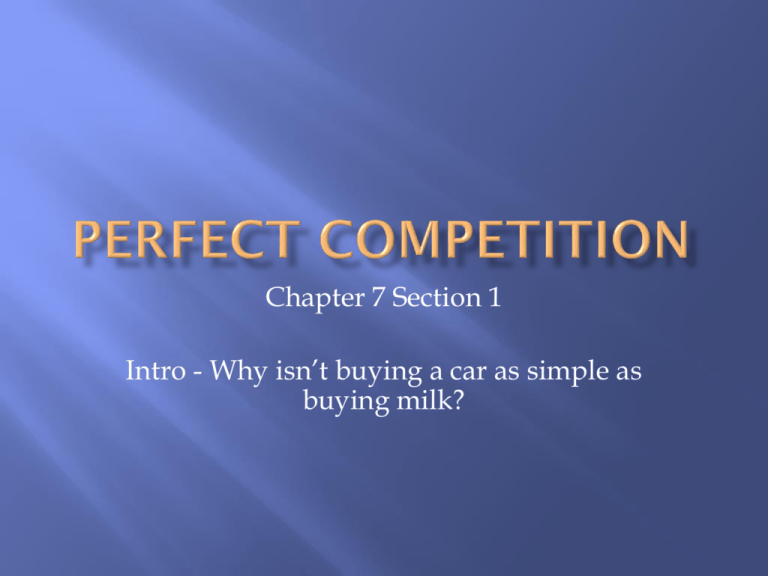
Chapter 7 Section 1 Intro - Why isn’t buying a car as simple as buying milk? • • • • • • • • • Tomatoes Cars Electricity Notepaper Water Dairy Farms Baseball Teams Kitchen Appliances Fast Food Arrange these items in a continuum from those that have the greatest to those that have the least competition within their market. Factors of a perfectly competitive market: Many buyers and sellers Identical Products No one can affect market price Qualifies as a commodity Informed Buyers and Sellers Free Market Entry and Exit •Tomatoes •Cars •Electricity •Notepaper •Water •Dairy Farms •Baseball Teams •Kitchen Appliances •Fast Food Why do some of these products not qualify as a perfectly competitive market? Also called “pure” competition is the simplest market structure. A large number of firms are all selling the same exact product. No firm is big enough to influence the price across the entire market. Price is set by equilibrium point. Price in a perfectly competitive market is set by the equilibrium point. A firm will have more success if they can lower the price, thus attracting more buyers. Gasoline How can they afford to lower the price of their product? What must they do in order to lower the price and remain profitable? Factors that make it hard for other firms to enter into the market are called barriers to entry. Start-Up Costs This leads to imperfect competition, the staple of this free market system. How can they vary from place to place? Technology Why is this a factor? Perfect Competition? Where things start to get a little cutthroat If you had the chance to monopolize an industry, would you do it? Why or why not? Even if it meant that you crushed your competition and put thousands out of business? What is market power? Get into groups of two! List 3 monopolies found within every school. List 2 monopolies that come into your home. List the benefits and drawbacks of each of these listed items. Why are some monopolies good while others are considered bad? When a monopoly is in place, what does the government do? Why? Are the results always beneficial? Economies of Scale! Producer’s average costs per unit falls as total output rises. A large firm can often produce a good for much cheaper unit cost than a small firm. The Norton Foods Corporation, for example, can produce a jar of strawberry jam for much less than Mrs. Beardsley, who produces a hundred jars a year for her family and friends. Norton foods buys glassware, sugar, strawberries, labels, etc. at wholesale prices with quality discounts. Also, they have time-saving efficient equipment. Mrs. Beardsley makes jam only once a year, it doesn't make sense for her to buy a lot of specialized equipment. What is one kind of monopoly that the U.S. government generally permits? Natural Monopoly - more efficient and effective when one company controls it. (Public Water) Government monopoly - Monopoly created by the gov’t Patent/franchise – limits entry of other firms, no competition. Professional Sports Teams – control over ticket prices, locations, number of teams, etc. Price Discrimination is the practice where businesses divide consumers into different subgroups and charge different prices for each group. This is to maximize profits. For example – If I open a restaurant, I would charge full price for adults. I might give senior discounts to encourage older customers to spend money, and I may give discounts for children to encourage families to attend. Why does the government ban most monopolies in the United States? Does this affect all countries? HW: bring materials for SEI on Monday



